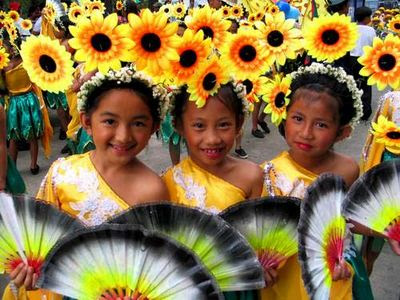





Sangyaw is a popular native festival held every 29th of June in Tacloban city. Sangyaw, which means “to announce or herald a news” in the local dialect, has assumed a popular following after its creation by then former First Lady Imelda Marcos in 1976. The current festivities became an annual event until 1986 when the late Corazon Aquino assumed the presidency and abolished Sangyaw. It was only in 2008 when Mayor Alfred Romualdez, a nephew of the former first lady, finally revived the Sangyaw festival and was readily accepted with by the reinvigorated Taclobanon community in the city and other parts of the region.
Sangyaw is religious in origin and traces its roots to a purely Taclobanon Christian beginning. Sangyaw Festival showcases the rich cultural and religious heritage of the natives of Tacloban and the province it belongs to. Warriors painted in colorful costumes, women performing elaborate rituals and the incorporation of Christianity are just some of the events featured in the event. The main attraction, however, is the devotion to the Sto. Niño, patron of Tacloban City. Local city contingents consisting of representatives from the different city schools and barangays will usually have a woman carrying the Sto. Niño statue who’ll dance in a trance, symbolic of the native Catholic ritual thanking the Sto. Niño for the blessings and luck it has brought to this lovely bayside city in Eastern Visayas. Historically, the Sangyaw is based on popular belief that the statue of Sto. Nino miraculously survived a shipwreck around 1880's. This was after the original icon, brought by the Spaniards in 1888, have to be brought back to Manila for reconstruction and refitting. On its way back to Tacloban, the steamer "Luzon" which was its carrier caught in a disastrous fire and sank. The alcalde or mayor of Tacloban that time, Hermano Mayor Arcadio Zialcita, felt the grief and sadness of the loss of a patron. Sometime in May of 1889, however, a letter from Military Governor Jose Gil de Avalle of Mindoro received by the Governor of Leyte to the effect that the Barrio Lieutenant of Barrio Semirara in Mindoro sighted a box labelled “Santo Niño, Patron han Tacloban.” Immediately volunteers were dispatched and finally recovered he image to reach the shores of Tacloban in June 30, 1889. The "salubong" or meeting place when the image was received with much celebration is around present-day Balyuan tower, near the Sto. Nino parish.
The Sto. Nino church in Tacloban has thousands of devotees all throughout the year. It is said that an intercession prayer to the Sto. Nino reaps miracles. Many such wonder miracles have been attributed to the Sto. Nino by the locals such as healing, good health, wealth, family, and guidance.
Today, the Sangyaw Festival is a cocelebration of that popular belief by adjoining with other localities from all over the Philippines to showcase their rich cultural heritage thru dances and religious pageantry. Many contingents join in hoping to bring home the bragging rights for the Php500,000.00 prize and a trophy, Second prize of Php300,000.00 and trophy and a third prize of Php200,000.00 and a trophy. Other prizes are for Best in Street Dancing, Best In Choreography, Best In Music, Best In Costume and Best In School and Community Showcase.
Mayor Alfred Romualdez and his wife, City First Councilor Cristina Gonzales-Romualdez, has been actively promoting the Sangyaw festival. Within a year of the festival’s revival, it has gained significant attention in the tourism industry and international recognition of a festival deeply rooted in Taclobanon tradition. Senator Juan Ponce Enrile is a staunch advocate who urged Department of Tourism (DOT) to promote the Sangyaw Festival of Tacloban City in overseas market to bring more tourists to the city in particular and the country in general. “The Sangyaw Festival is so impressive that it could be in the list of must-see attractions in the country”, he was quoted as saying.
No comments:
Post a Comment